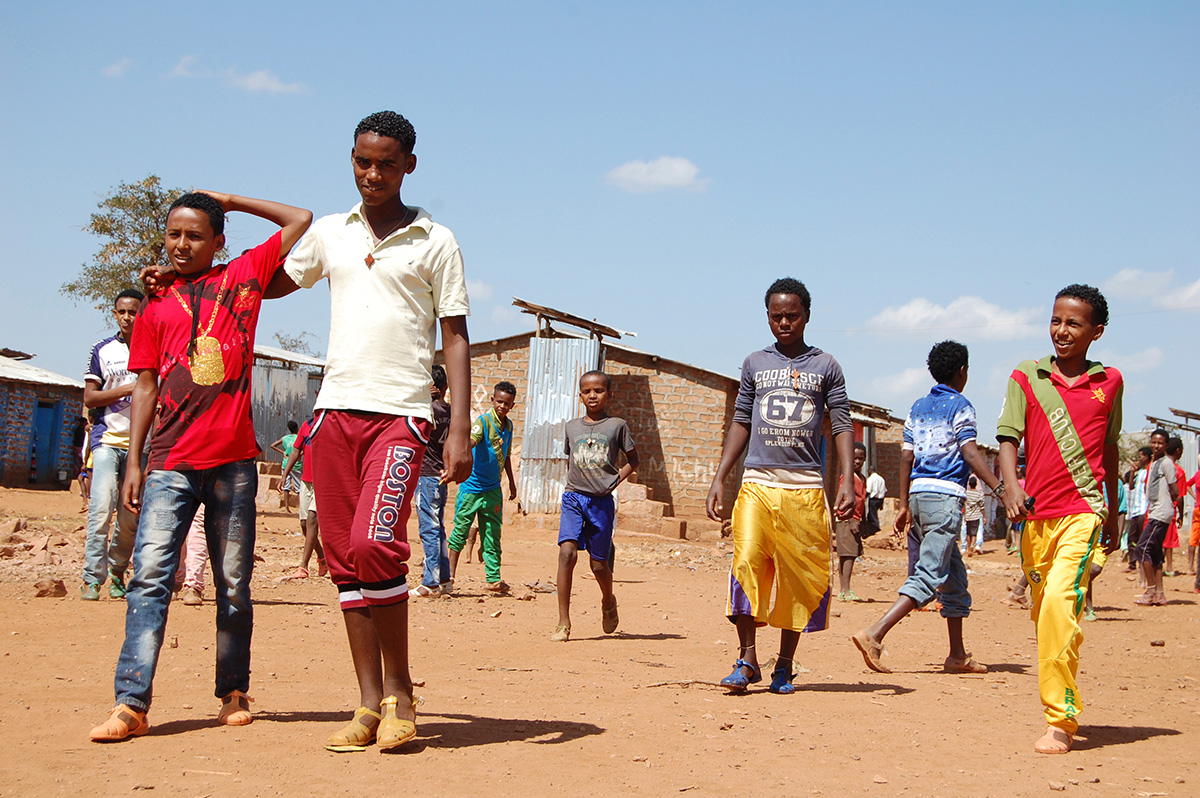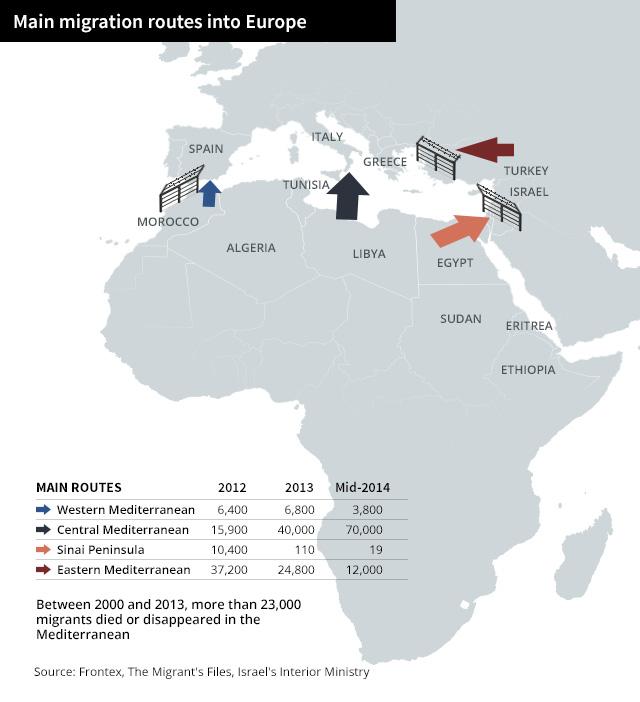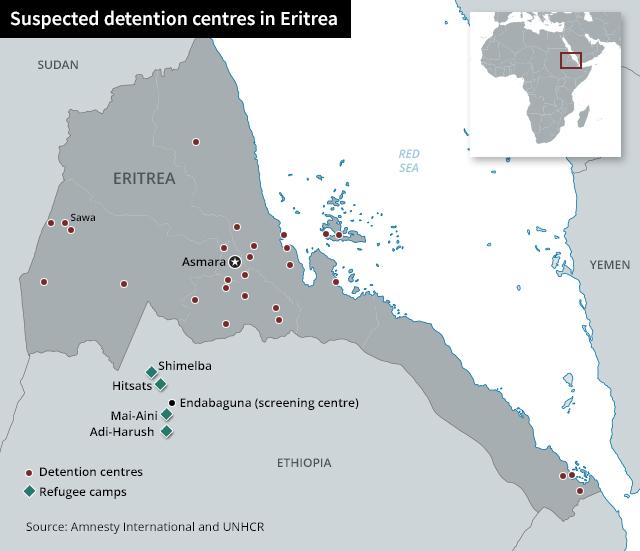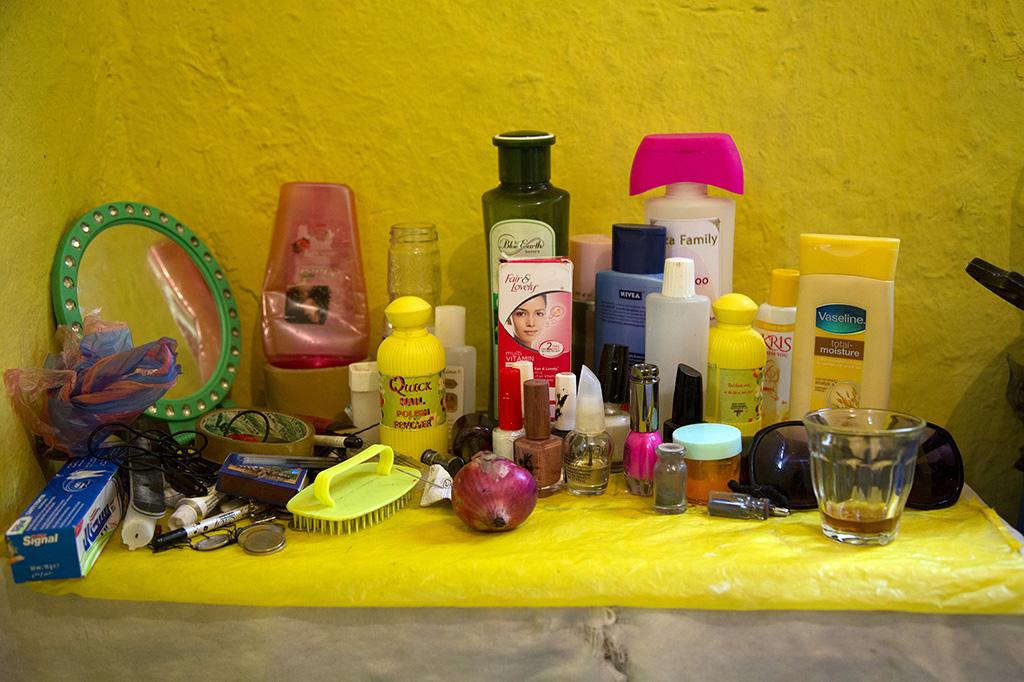
The Swiss hopes of refugees with nothing to lose

A nation at forced labour
Fleeing a repressive regime at home, thousands of young Eritreans cross the frontier with Ethiopia every month. It’s the first stage on the way to Europe. swissinfo.ch talked to these refugees, some of whom have dreams of reaching Switzerland.
Mebrathon has agreed to meet me in a park on the edge of the city. The taxi makes its way through the throng of construction workers and beggars holding out their hands for a few birr. With its three million inhabitants, Addis Ababa is undergoing a construction boom.
Old neighbourhoods are giving way to hotels, residences and large stores. At 2,330 metres above sea level, the Ethiopian capital reflects the hopes for prosperity of a whole people, 30% of whom live below the poverty line, according to the World Bank.
For the Eritrean refugees, Addis is a foreign city, sometimes a hostile one, a place of passage and waiting. The telephone rings. It’s Mebrathon. “It would be better to meet in a car park. There are too many people here. I don’t feel safe.”
A native of Eritrea, Mebrathon is 39 and has a lost look. He speaks in an undertone. “I arrived in Ethiopia a year-and-a-half ago, but I am leaving the day after tomorrow. I can’t stand it any more, waiting around.”
He already has his rucksack packed – a pair of jeans and a T-shirt, a Bible and some money. A people smuggler is going to get him into Sudan and another into Libya. There he will wait for a boat to cross the sea to Italy. The whole journey will take months.

According to the UN refugee agency (UNHCR), over 4,000 Eritreans illegally cross the border to Ethiopia or Sudan every month, fleeing from the totalitarian regime of Isaias Afewerki.
The first and only president of an independent Eritrea has militarised society with his rhetoric of a situation that is “neither war nor peace” with Ethiopia.
All citizens, men and women, have to serve in the army or a state organisation for an indeterminate period, like convicts. Fugitives and deserters are branded enemies of the people. If they are caught, they go to prison or pay with their livesExternal link.
Mebrathon was enrolled in the army at 16 years of age. “At first I was guarding the border with Ethiopia. We had orders to shoot anyone trying to cross. I worked day and night for 450 naktfa, which is about $30 (CHF28).”
The first time he tried to escape he was just over 30. Soldiers caught him, he was put in an underground cell and tortured. Mebrathon lights a cigarette, his wrists still showing the marks of handcuffs.
His second escape bid took him to Asmara, his home town, where he lived illegally for three years.
“I could never sleep two nights in the same place. I worked as a waiter, with forged papers. But when the army started questioning my family and the city was completely militarised, it was too dangerous to hide, so I got a people smuggler to get me to Ethiopia.”
The trip, involving a trek of 18 hours avoiding guard posts and snipers, cost $2,000 and was paid for by a sister in the US.

Crossing the Ethiopian border
From Addis Ababa we move north to the historic region of Tigray, a few kilometres from the border, which in 1998 became a war zone between Ethiopia and Eritrea.
In this semi-arid landscape where the sun beats down, refugees find an initial, temporary place of refuge. Once across the border they are escorted by Ethiopian troops to the registration centre at Endabaguna.
With over 620,000 refugees registered, of whom 100,000 are Eritreans, Ethiopia maintains an “open door” migration policy, as Michael Owor, manager of the Tigray section of UNHCR, explains: “No one is being sent back.”
A generous policy, to be sure, but one which fits uneasily with the bureaucratic and police system of the Ethiopian state, with the lack of funds and with the limitations imposed on NGOs, which can hardly be seen in the camps in the north.
I arrive at Endabaguna around lunchtime. I have barely arrived before I am taken in charge by the authorities. They run these camps – no photographs, no interviews with refugees. My presence is not particularly welcome.
Several hundred Eritreans are seated under an awning, waiting for their food rations. At this centre, there are no real reception facilities to speak of.
The refugees are supposed to stop here only for a few hours, the time it takes for an initial hearing. But the camps are all full, and at times the centre at Endabaguna turns out to be a stopover lasting several weeks.
Not far away, in a dismal-looking building, a little boy sleeps on the ground. He crossed the border alone a few days ago. He is not an exception. Since the start of this year, the UN refugee agency has noted a marked increased in the number of unaccompanied minors arriving both in Ethiopia and Sudan.

More
Growing up in a camp without parents
In the camps, privation and hope
Following the route of the migrants, I travel on to the camp at Hitsats, opened last year. This is where new arrivals usually go. The unpaved road winds up through the mountains and then down through country villages where houses are still built of tree trunks.
With a population of some 20,000 refugees, Hitsats could be considered a town. But while in other camps there are at least some facilities – a medical dispensary, a school, a convenience shop – here not even the most basic services are available.
“Sometimes there is not even enough drinking water and electricity for all. The region is poor in natural resources, and they have to be shared between the refugees and the locals. There are not the financial means to respond adequately,” Owor says.
Free for a moment from prying eyes, Danait shows us into her tent, which she shares with a group of ten refugees, men included. Sitting on the matress, she keeps moving her leg nervously. She is 23 but looks like a very young girl.
“In the camps we are like vegetables. We wake at sunrise. We make breakfast and sit and talk about our future. Always the same questions, the same stories. In the afternoon we go for a walk around the village, till dinner time. Then we wait to go to sleep, always with one eye open.”
Speaking Italian with an accent reminiscent of Lombardy, Danait tells us she studied at the Italian School in Asmara and won a scholarship to the University of Rome. But getting an exit visa from Eritrea is impossible for anyone who is young, healthy and eligible for military service. She too ended up in uniform.
Like all Eritrean young people, she spent her last year of school at the military training centre in Sawa. Then she was detailed to be a domestic servant.
“The sergeant wanted more than just dinner…so I escaped.” Danait has only been in the camp for a few months; her friend Teddy has been here for years. “I was trying to get to Israel,” he says, “but I was kidnapped in the Sinai [Peninsula] and sent back here.”
A frowning face looks into the tent. It is the head of the camp, calling me to follow him to his office. “We can talk there in peace,” he says. There, of course, he will have better control of the situation.
The refugees I met do not trust the authorities, who are accused of taking bribes, and they do not feel safe in the camps.
“There are stories going round of women raped and refugees kidnapped. At night I never go out alone,” says Danait.
The UN refugee agency is aware of these stories, but plays them down. Later the regional head of the national migration authority denies the charges of corruption, but he admits it is difficult to ensure safety in the camps.
“With a lot of young males there, alone, cases of violence are more frequent compared with camps where there are mainly families with children.”
Ethiopia not an option
For most of the Eritrean refugees, Ethiopia is not the destination of choice, but a necessary staging point for onward migration.
On the one hand, the crisis in Eritrea has been going on for decades and the lack of any prospect of change rules out the idea of going back; on the other, the refugees have trouble finding work opportunities in Ethiopia, and those that they do find are a lot less attractive than the idealised picture they have of Europe.
“Young people in their twenties dream of having a family, a job and a qualification,” says Ramsey Bryant, who heads the UNHCR department of protection in Tigray. “It is understandable that they should want to get out of the camps, because here they have no future. On the other hand, the mandate of the UNHCR in the camps is to respond to a humanitarian crisis – that’s all.”
In Ethiopia, refugees do not enjoy freedom of movement. The government allows people with serious health problems to live in a town and provides opportunities for a small number of young people to study. This is a programme intended solely for Eritreans, due to a common culture that may help to foster integration. Only some 300 actually benefit, which is 0.3% of the 100,000 refugees on the books.
For people who do not fit into this category, to leave the camps they have to give evidence of sufficient funds to support themselves – usually, this means money sent by relatives abroad. This is the case with Jamila* and Sophia*, who fled Eritrea hoping to join their brother Asmaron* in Switzerland. I met them on my return to the capital, two young girls lost in a big city.
Dream of Switzerland
Jamila had hardly come of age when she crossed the frontier, a year ago. Since then, she has not let go of her sister Sophia’s hand. She has arranged the meeting and is watchful, a look of suspicion on her face.
“How do we know that you are not from the embassy?” After we have a coffee, the atmosphere relaxes a bit. Jamila heats up the leftovers of some vegetables and a cob of corn on a little charcoal stove. She hands me a morsel wrapped in some injera, the typical local bread made of teff flour. This is a sign of welcome that is exchanged twice according to the traditional etiquette.
This room of three metres by four contains everything Jamila and Sophia own. They get by on $100 a month. “It’s not much, but we try to make do.” Here in Addis Ababa they know practically no one; they speak neither English nor Amharic, the official language of Ethiopia.

“At the beginning we were afraid to go out, but now we are beginning to find our way around the neighbourhood and can say a few words.”
Having fled from Eritrea in August 2013, Jamila and Sophia have been waiting for months for a response from the Swiss migration authorities. Their brother has applied for them under family reunification rules. “We dream of being able to study and to help our parents in Eritrea.”
The girls have no idea what stage their application is at. They are nervous and fearful. They do not know that Asmaron will have to convince the authorities that he has a job and an apartment big enough to house and keep them. Conditions like these are not always easy to meet for someone living in Switzerland with refugee status or temporary residency.
A few blocks away we meet 26-year-old Senait. A few weeks ago she got a call from the Swiss embassy: her asylum request had been rejected. Her husband, several years in Switzerland, tried to reassure her.
“He told me he was going to appeal. He does not want me to go to Libya as it’s too dangerous. But what am I to do here on my own? If I can get across the sea and arrive in Switzerland, they won’t send me back… will they?”
Perilous route
The migrants know what hazards await them on the route through Libya. Shipwrecks at sea, inadequate water rations to cross the desert, Libyan prisons, or the risk of being kidnapped in Sudan and sold to the Bedouin of Sinai. Like Milena and her four friends. “We were kept in a prison over a year. They beat me and raped me.” She says it just like that, looking me straight in the eye.

This reportage was carried out as part of eqda.ch, a journalistic exchange project between Switzerland and developing countries.
According to human rights organisations, tens of thousands of migrants have been kidnapped since 2009, mostly Eritreans. The procedure is always the same: “While they were torturing us, they would phone our families to demand a ransom.”
The figure ranges from $30,000-40,000, which people scrape together among friends, relatives and moneylenders. Whoever survives the ordeal often ends up in an Egyptian prison waiting to be expelled back to Ethiopia.
Senait has heard this kind of story several times. But her decision is made. Two days after I left, she left too. The first stage is the Sudan. From there she will plan the rest of the trip.
“The hardest thing is finding a people smuggler you can rely on. But I have been asking around and I have a few names.” I ask her if she is afraid. “Of course I am afraid. But I have nothing to lose and my life is in God’s hands.”
*Names have been changed.
First stop: Ethiopia
The choice of Ethiopia or the Sudan as a destination is dictated by geographical proximity, cultural affinity or family ties. But in recent years the Sudanese frontier has become more and more dangerous: Eritreans risk being forcibly sent back or kidnapped in the camps and sold to Bedouin tribesmen. Many therefore now opt for Ethiopia, although this means an extra step on the journey to Europe.
Costs of the trip
Eritrea – Ethiopia (Sudan): $1,500-2,000
Ethiopia – Sudan: $1,500
Sudan – Libya: $1,500
Libya – Italy: $2,000-2,500
To pay the people smugglers, the Eritrean migrants often have to call upon the resources of family and friends, especially those living abroad. Many have to get into debt and even prolong their journey to work on building sites in Libya or the Sudan.
Destination: Europe
Since Israel built a 230km wall along its border with Egypt, thus effectively sealing the frontier, the Mediterranean route has been the one most used by Eritrean migrants. The number of landings on the Italian coast has increased due to the chaos now reigning in Libya and also due to operation Mare Nostrum, launched in October 2013 by Italy to come to the aid of migrants at sea.
Large diaspora
The Eritrean population is thought to be five million: at least a fifth has fled abroad, to the Sudan, Ethiopia, Israel and of course Europe. Along with Sweden, Norway, Germany and the Netherlands, Switzerland is a favourite destination for Eritreans. In the first seven months of 2014, 4,043 of them asked for asylum. In the past five years, about 65% of the applicants have been given refugee status. This is despite the fact that deserters and conscientious objectors no longer qualify for asylum, according to changes to the law approved by Swiss voters on June 9, 2013.
Source: Federal Office of Migration
Reasons for flight
Since it gained independence in 1993, Eritrea has been under the iron-fisted rule of Isaias Afewerki (59), a revolutionary leader trained in Mao’s China. His regime is considered one of the most repressive and paranoid in the world; the country is one of the ten poorest. In June 2014, the UN Human Rights Council decided to launch an investigation of the situation in Eritrea, an approach it has taken so far only with Syria and North Korea.
Source: UN Human Rights Council
(Translated from Italian by Terence MacNamee)

In compliance with the JTI standards
More: SWI swissinfo.ch certified by the Journalism Trust Initiative




























You can find an overview of ongoing debates with our journalists here . Please join us!
If you want to start a conversation about a topic raised in this article or want to report factual errors, email us at english@swissinfo.ch.